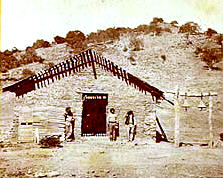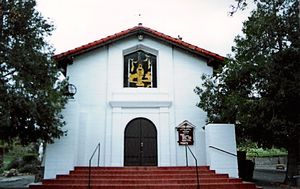Santa Ysabel Asistencia
| This article is part of a series on the Spanish missions in California  The capilla (chapel) at the Santa Ysabel Asistencia, circa 1875.[1] | |
| HISTORY | |
|---|---|
| Location: | Santa Ysabel, California |
| Coordinates: | 33° 7′ 49″ N, 116° 40′ 41″ W |
| Name as Founded: | Asistencia de la Misión San Diego de Alcalá [2] |
| English Translation: | Attendant to the Mission San Diego de Alcalá |
| Patron Saint: | Saint Elizabeth (Isabel), Queen of Portugal |
| Founding Date: | September 20, 1818 [2] |
| Founded By: | Father Fernando Martín [2] |
| Military District: | First [3][4] |
| Native Tribe(s): Spanish Name(s): |
Kumeyaay (Ipai), Payomkowishum Diegueño, Luiseño |
| Primordial Place Name(s): | Elcuanan [5] |
| DISPOSITION | |
| Caretaker: | Roman Catholic Diocese of San Diego |
| Current Use: | Chapel / Museum |
| California Historical Landmark: | #369 |
The Santa Ysabel Asistencia was founded on September 20, 1818 at La Cañada de Santa Ysabel in the mountains east of San Diego (near the village of Elcuanan), as a "sub-mission" to Mission San Diego de Alcalá, and to serve as a rest stop for those traveling between San Diego and Sonora, Mexico. The native population of approximately 450 neophytes consisted of both Luiseño and Diegueño peoples. Based on historical records, Santa Ysabel enjoyed a higher-than-average conversion rate when compared to the other California missions. Given its remote location, the facility was visited infrequently by the padres after secularization of the missions in the 1830s. Designated as a California Historical Landmark, today the chapel serves as a parish church within the Roman Catholic Diocese of San Diego.
History
Mission Era (1769 – 1833)
Father Juan Mariner first visited the site in 1795. In 1816, mission fathers in San Diego formally requested permission from the Spanish Governor to establish the asistencia. Fray Martin presided over the inaugural mass on the last day of September, 1818. By 1821, a chapel, granary, several adobe houses, and a cemetery had all been constructed on the site. In September of that same year Father Mariano Payeras, "Comisario Prefecto" of the California Missions, visited the area as part of a plan to establish an entire chain of inland missions, with Santa Ysabel as the "mother" mission. The plan never came to fruition, however.
Rancho Era (1834 – 1849)
From about 1836 onward, regular visits by the priests became less frequent until they stopped altogether. The Santa Ysabel Rancho was granted to Jose Joaquin Ortega and Edward Stokes in 1844; two years later General Stephen W. Kearny and the "Army of the West" made camp on the rancho on their way to the Battle of San Pasqual. Jean Baptiste Charbonneau, son of Sacagawea, camped at the Mission in 1847 after guiding the Mormon Battalion from New Mexico to San Diego. In 1849, U.S. Army Lieutenant A.W. Whipple visited the site during the course of the United States and Mexican Boundary Survey and documented the Mission's condition as being "in ruins."
California Statehood (1850 – 1900)

The Church of Saint John the Baptist, erected on the site of the original Santa Ysabél Asistencia in 1924.
In 1850, the roof caved in and ramadas (shelters) were erected against one wall in order to allow religious services could continue. John Russell Bartlett, an American traveller who passed by the Mission proper in 1852, noted that the facility consisted of little more than a roofless church and a few simple huts; nothing remains of the original structures due to neglect over the years. The title to Rancho Santa Ysabel was confirmed to Ortega and Stokes in 1873. In 1898 The Santa Ysabel Indian Reservation was established.
The 20th Century and beyond (1901 – present)
After three acres of the original Mission compound are returned to the Roman Catholic Church, Father Joseph Exalaphat Lapointe, a French-Canadian missionary, came to Santa Ysabel in 1903 to work with the locals.(Padres and Indians: Settling San Diego County's Frontier by Sandra A Maynes 2001). The cornerstone for a new, Mission Revival Style chapel (situated atop the site of the former adobe) was laid on September 14, 1924. LaPointe died in 1932 and was buried next to the chapel.
The "Mystery of the Lost Bells"
Bells were vitally important to daily life at any mission. The bells were rung at mealtimes, to call the Mission residents to work and to religious services, during births and funerals, to signal the approach of a ship or returning missionary, and at other times; novices were instructed in the intricate rituals associated with the ringing the mission bells. In 1846, two bells, the oldest in Alta California, were purchased from Misión Nuestra Señora de Loreto Conchó (Our Lady of Loreto) in Loreto, Baja California Sur, Mexico in exchange for six burro loads of barley and wheat. The bells were inscribed: "N.S. De Loreto 1723" and "San Pedro 1767." After the Mission began to deteriorate in the 1830s, and the bells were hoisted onto the yoke shown in the photograph at right. On a summer night, in 1926, the bells disappeared, apparently stolen. The day after they disappeared, a local named Jose Maria Osuna found the clappers (bell ringers) and took them home for safekeeping. After Osuna's death, the clappers were passed down to others, until they were eventually returned to the Mission in 1959. In 1966, a remnant of one of the bells was discovered; details regarding where and how it was found have never been revealed.
In 1993, a local molder named Ed Schwaesdall and his son John struck a new bell (made mostly of brass and copper) and donated it to the Mission in honor of the installation's 175th anniversary. A piece of one of the Mission's original two bells was recovered in 2012 with the assistance of Cal State Fullerton’s Center for Oral and Public History (COPH).[6]